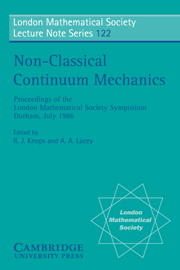 Non-Classical Continuum Mechanics
Non-Classical Continuum Mechanics Book contents
- Frontmatter
- FOREWORD
- Contents
- LIST OF PARTICIPANTS
- PART I PRINCIPAL LECTURES
- Pulse Reflection by a Random Medium
- Shape Memory Alloys-Phenomenology and Simulation
- Relativistic Extended Thermodynamics
- Spectra of Singularly Perturbed Operators
- Conservation Laws in Continuum Mechanics
- On Geometric and Modeling Perturbations in Partial Differential Equations
- The Appearance of Oscillations in Optimization Problems
- PART II SINGLE INVITED LECTURES
Pulse Reflection by a Random Medium
Published online by Cambridge University Press: 11 May 2010
- Frontmatter
- FOREWORD
- Contents
- LIST OF PARTICIPANTS
- PART I PRINCIPAL LECTURES
- Pulse Reflection by a Random Medium
- Shape Memory Alloys-Phenomenology and Simulation
- Relativistic Extended Thermodynamics
- Spectra of Singularly Perturbed Operators
- Conservation Laws in Continuum Mechanics
- On Geometric and Modeling Perturbations in Partial Differential Equations
- The Appearance of Oscillations in Optimization Problems
- PART II SINGLE INVITED LECTURES
Summary
Introduction
The study of pulse propagation in one dimensional random media arises in many applied contexts. While reflection and transmission of monochromatic waves was studied extensively some time ago [1–6 and references therein], new and perhaps surprising results emerge in the study of pulses that cannot be understood simply from the single frequency analysis by Fourier synthesis. The numerical study of Richards and Menke [7] drew our attention to these questions and led to [8] and [9]. Here we extend and simplify the analysis of [8] and give several new results. The computations are at a formal level comparable to the one in [8].
In [8] we analyzed the reflection of a pulse that is broad compared to the size of the inhomogeneities of the random medium. The random functions characterizing the medium properties were statistically homogeneous. We gave a rather complete description of the reflected signal process in a well defined asymptotic limit in which it has a canonical structure. We introduced the notion of a windowed process and showed that the canonical reflection process is windowed and Gaussian. We found a scaling law for the power spectral density but not its explicit form. All this was subjected to extensive numerical simulations in [9] where an intrinsic scaling, localization length scaling, was introduced that makes comparison to the theory much more reliable. This intrinsic scaling idea is not fully understood theoretically but seems to be very promising.
In this paper we extend the analysis to random media that are not statistically homogeneous. The incident pulse is now broad compared to the size of the inhomogeneities but short compared to the scale of variation of the mean properties.
- Type
- Chapter
- Information
- Non-Classical Continuum MechanicsProceedings of the London Mathematical Society Symposium, Durham, July 1986, pp. 3 - 21Publisher: Cambridge University PressPrint publication year: 1987
